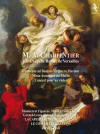Texte paru dans: / Appeared in: |
|
|
|
Outil de traduction (Très approximatif) |
|
Reviewer: J.
F. Weber Jordi Savall took part in the first annual festival of Baroque music at Versailles in 1988, an event that marked, as H. Wiley Hitchcock pointed out, the first time “baroque” had been used of music that the French had always called “classique.” His appearance also marked the début of Le Concert des Nations, his new ensemble. He performed a program of Marc-Antoine Charpentier’s sacred music, made up of pieces catalogued in 11 places in Hitchcock’s Catalogue Raisonné but named after the title of the first piece, and recorded the program the following February. At the same time, William Christie performed the Te Deum and Missa Assumpta est Maria, performances that, as evidenced by the performances of the Litanies de la Vierge by both choirs, starkly contrasted the popular theatricality of Christie and the zealous devotion of Savall (as Ivan Alexandre characterized them in Diapason). Both performances were repeated the next night, so anyone could hear both concerts. Christie recorded his program shortly before the concert, and the resulting discs from both conductors were reviewed together by me (Fanfare 13:2). The review is lengthy and informative enough to be worth searching out in the Fanfare Archive. Sixteen years later, Savall returned to another Versailles festival to perform the same Mass that Christie had done and a shortened version of his own Canticum group.
This elegant package (one of
the large bound books that Alia Vox issues at least once a year) exemplifies
this history. One disc is an SACD reissue of that 1989 recording, the other
CD a live recording of the 2004 performance of the Mass along with a brief
piece, Nuit. The second disc is filled out with a sizable instrumental work
recorded in 2013. Finally, the DVD, filmed at the 2004 performance, includes
only the three largest pieces from the Canticum group, Nuit, and the Mass,
the last two as heard on the second disc. The full contents of the group
titled “Canticum” in the headnote are as follows: Canticum in honorem Beatae Virginis Mariae inter homines et angelos, H 400. Symphonie devant Regina, H 509. Pour la conception de la Vierge, H 313. Nativité de la Vierge, H 309. Prélude pour Salve Regina, H 23a. Salve Regina, H 23. Pour la fête de l’Épiphanie, H 395. Prélude pour le Magnificat, H 533. Magnificat, H 80. Stabat Mater, H 15. Litanies de la Vierge, H 83.
Of these, H
400, H 15, and H 83 are on the DVD from the 2004 performance. Savall’s late
wife, Montserrat Figueras, sang in the 1988 recording but did not appear in
2004. The Mass, the last of the composer’s 11 settings, is one of the great sacred works of the Louis XIV era, set for six voices and a small ensemble. It dates from 1698 or later, when the composer joined the Sainte-Chapelle as master of the choirboys, a position that he held for the remaining six years of his life. When Christie’s 1988 recording appeared (it was later issued in Super Audio, 33:1), it was easily superior to the two previous recordings. It makes an interesting comparison with Savall’s 2004 live performance, which differs in subtle ways and in one major respect from the Christie version. Christie adopted period pronunciation of the text (as did later recordings under Ivor Bolton and Hervé Niquet), while, as in the 1988 festival, Savall eschewed period pronunciation, “giving priority to the universal elements of the Latin language,” as he put it in the original notes. Christie’s pairing of the most well known Te Deum and the Mass is still a spectacular achievement, but Savall affords a different view of the Mass, studied from a different perspective. His filler, an instrumental work first recorded as far back as 1959, is blessed with the subtle articulation of Savall’s group of four viols with violone and theorbo. Savall’s singers and players have absorbed his spiritual response to the music and executed it with aplomb. His daughter, Arianna Savall, gives a beautiful performance as the leading soprano in the Mass, a true reflection of her mother, and the lead bass is Daniele Carnovich, a stalwart of several Baroque ensembles. This is a real alternative to the fine Christie version of the Mass. All three sources (1988, 2004, 2013) have been mastered in Super Audio for CD. The DVD of the 2004 performance at Versailles is lovely. The “men and angels” of H 400 are situated on two levels for their dialogue, the pair of sopranos high above the floor. The royal chapel of the palace is elegantly Baroque in architecture, but the camera work concentrates on the performers, with just a glance or two at the audience and occasional appreciation of the architecture. The technical side is described as PCM coding, PAL format, and region 0 (universal), but it would not play on my DVD player. On my Blu-ray player it provided a beautiful wide-screen picture that my untutored eye would judge to be high-definition. As Alia Vox’s book-type issues go, this ranks as my favorite on account of the content. This sort of thing makes a great gift for a music lover, but keep one for yourself, too. | |
|
|
|
|
|
|
|
Cliquez l'un ou l'autre
bouton pour découvrir bien d'autres critiques de CD |
|




